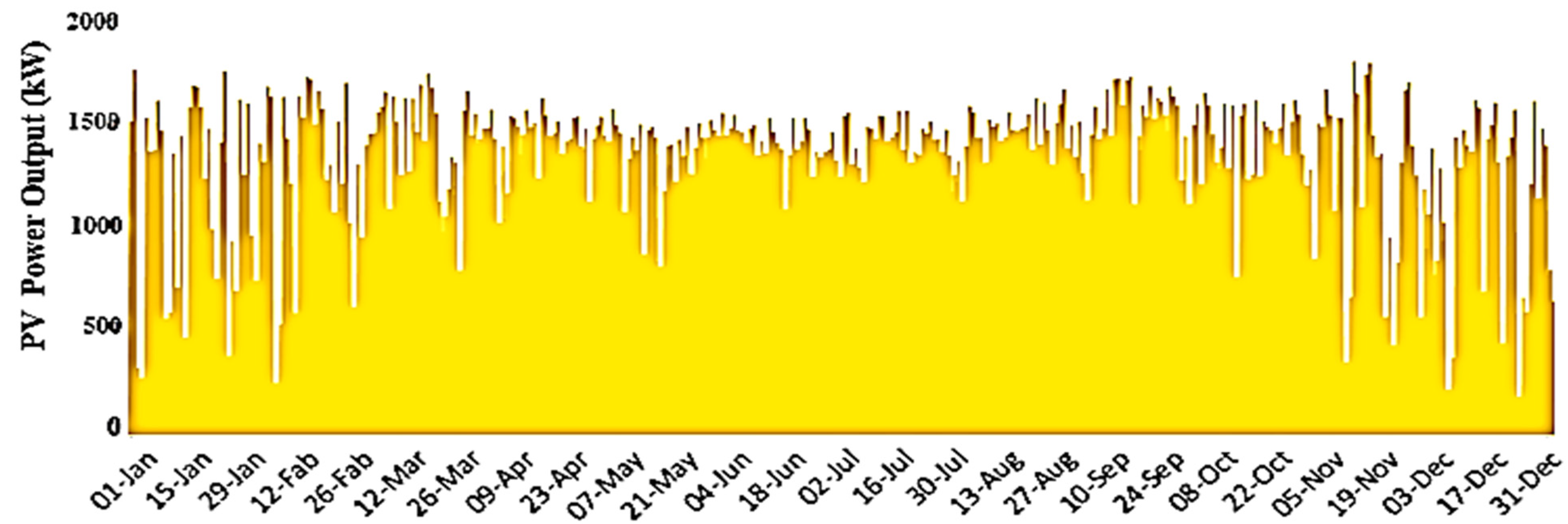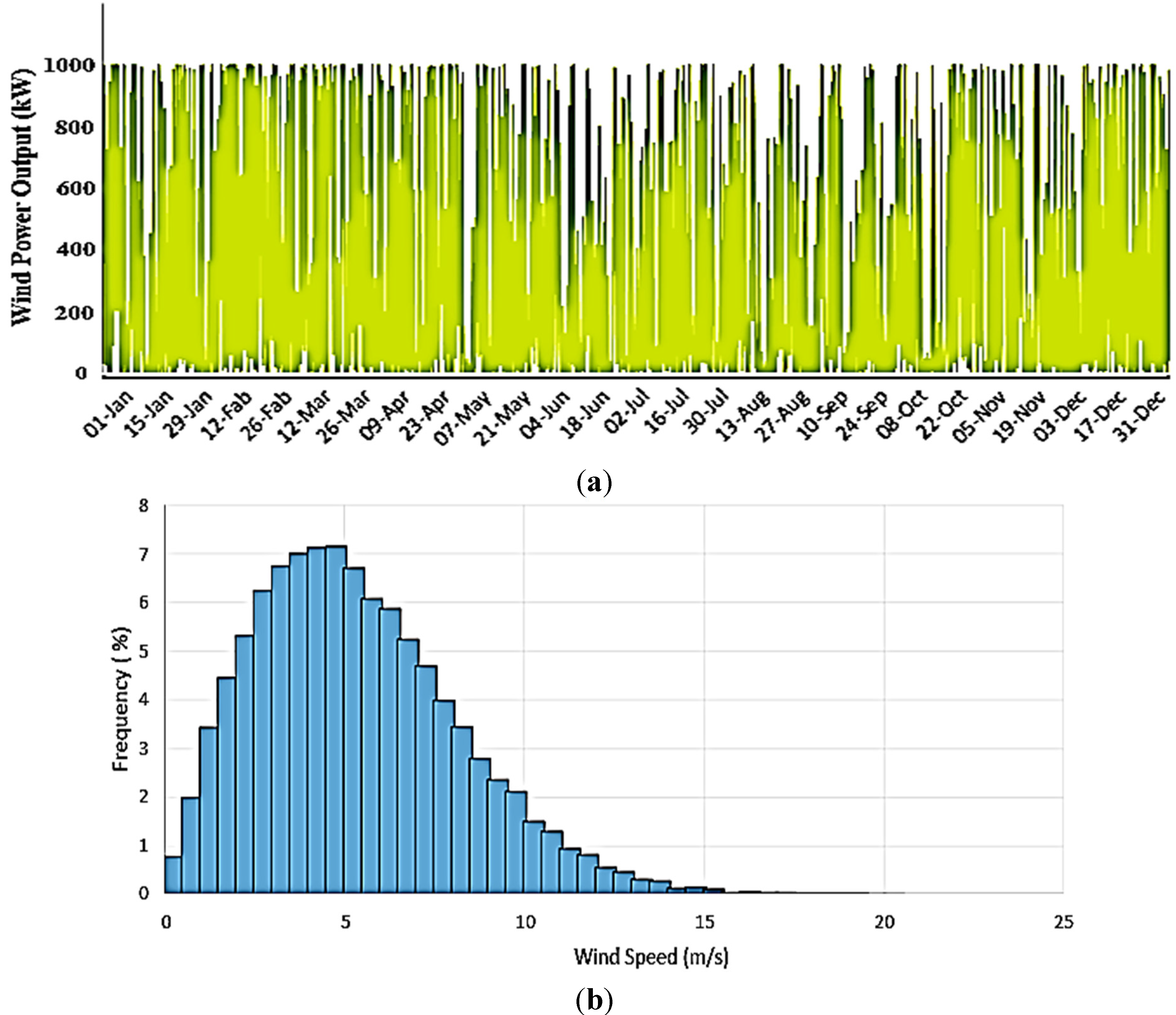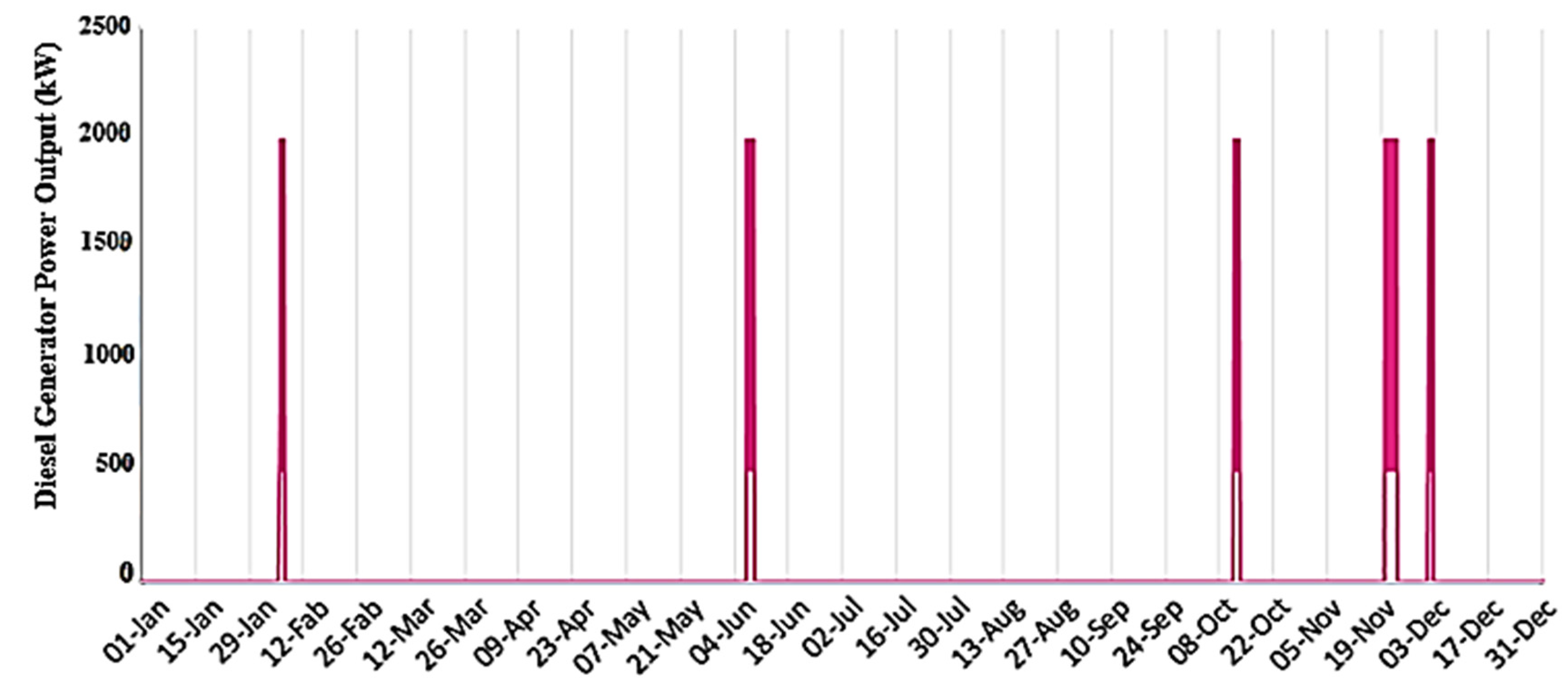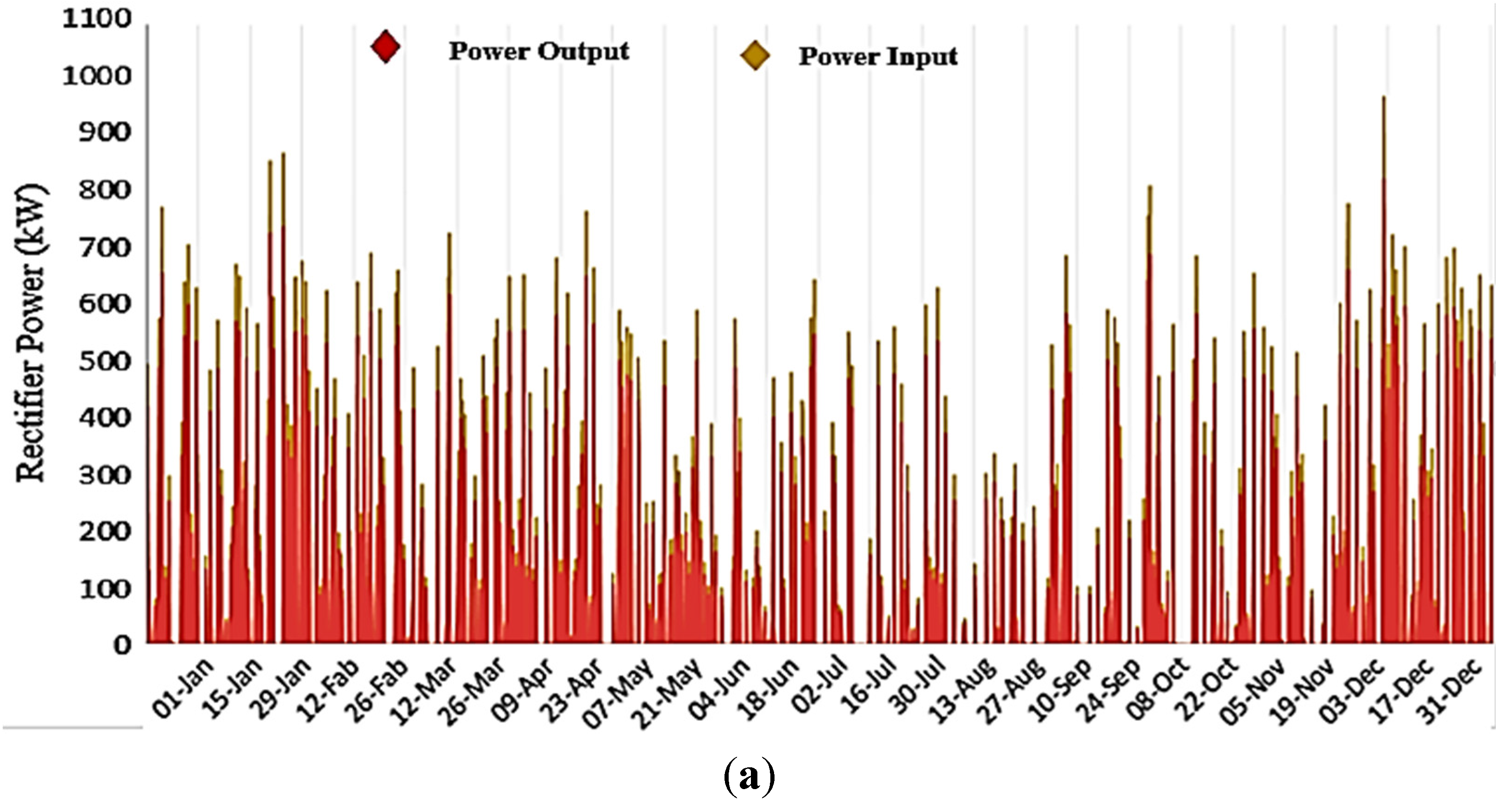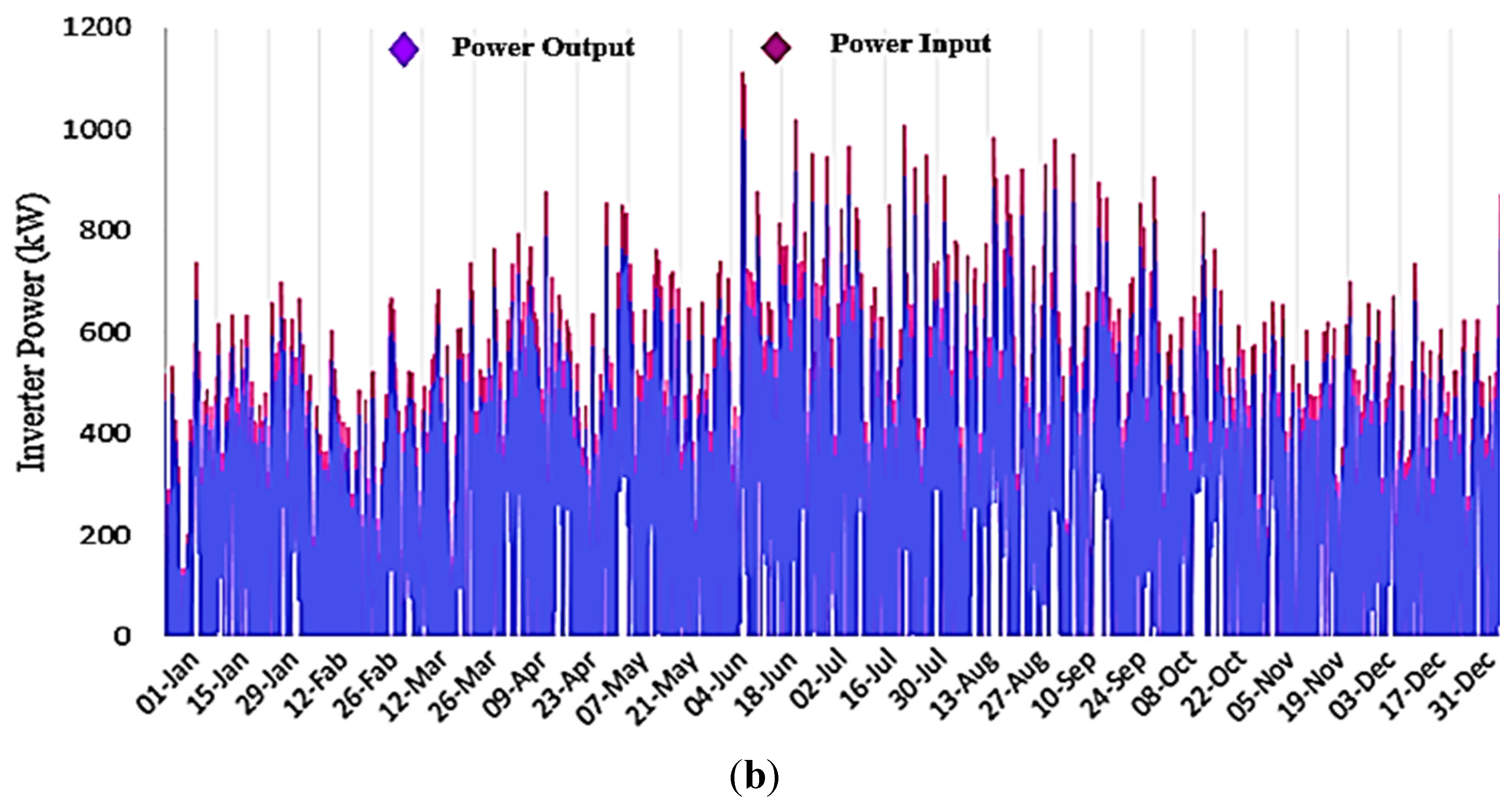An Environmentally-Friendly Tourist Village in Egypt Based on a Hybrid Renewable Energy System––Part Two: A Net Zero Energy Tourist Village
Abstract
:1. Introduction


2. Literature Review
3. Electric Load
- the day-to-day variability is taken as 5% in this study.
- the time-step-to-time-step variability is taken as 5% in this study.
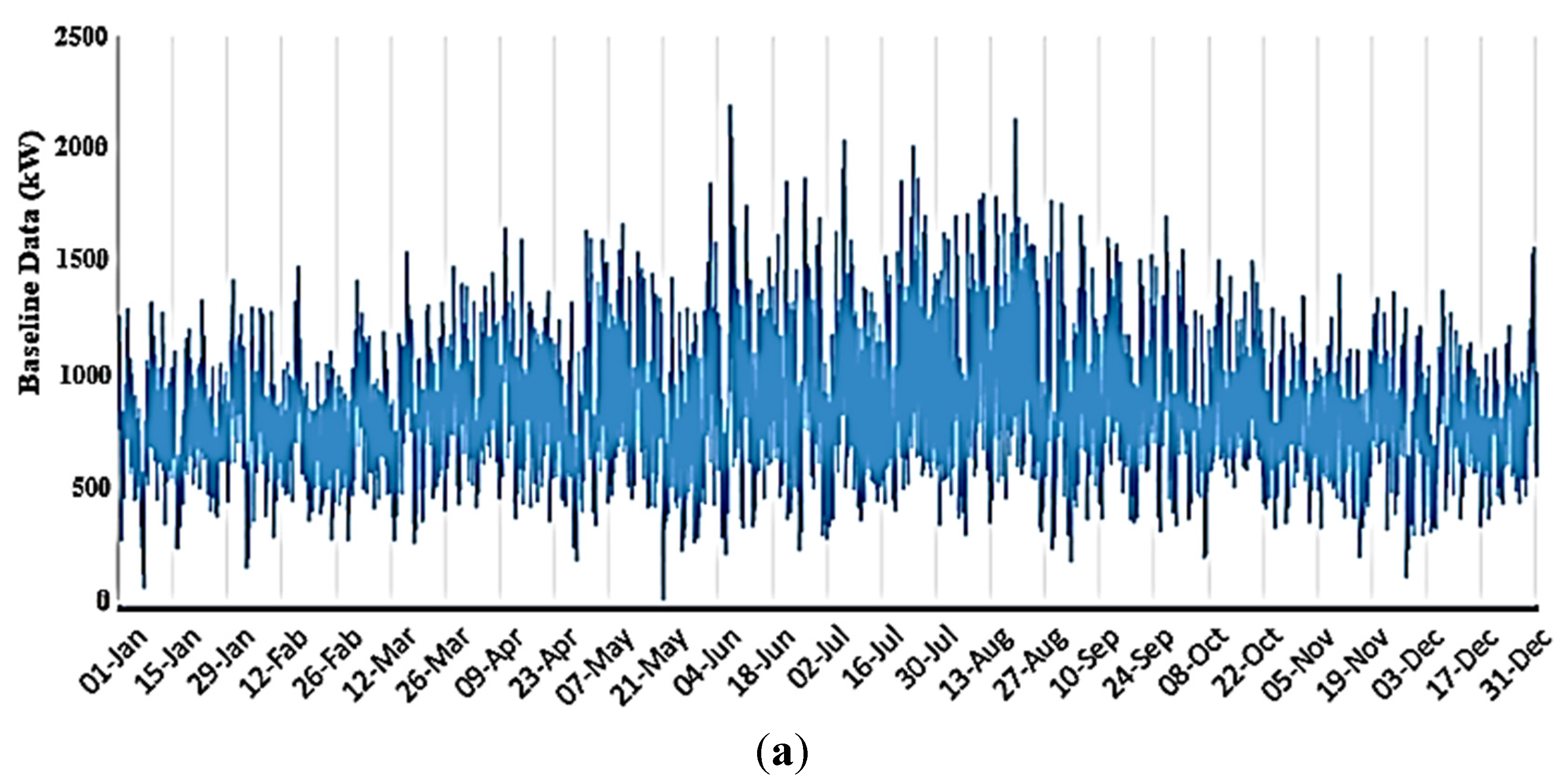
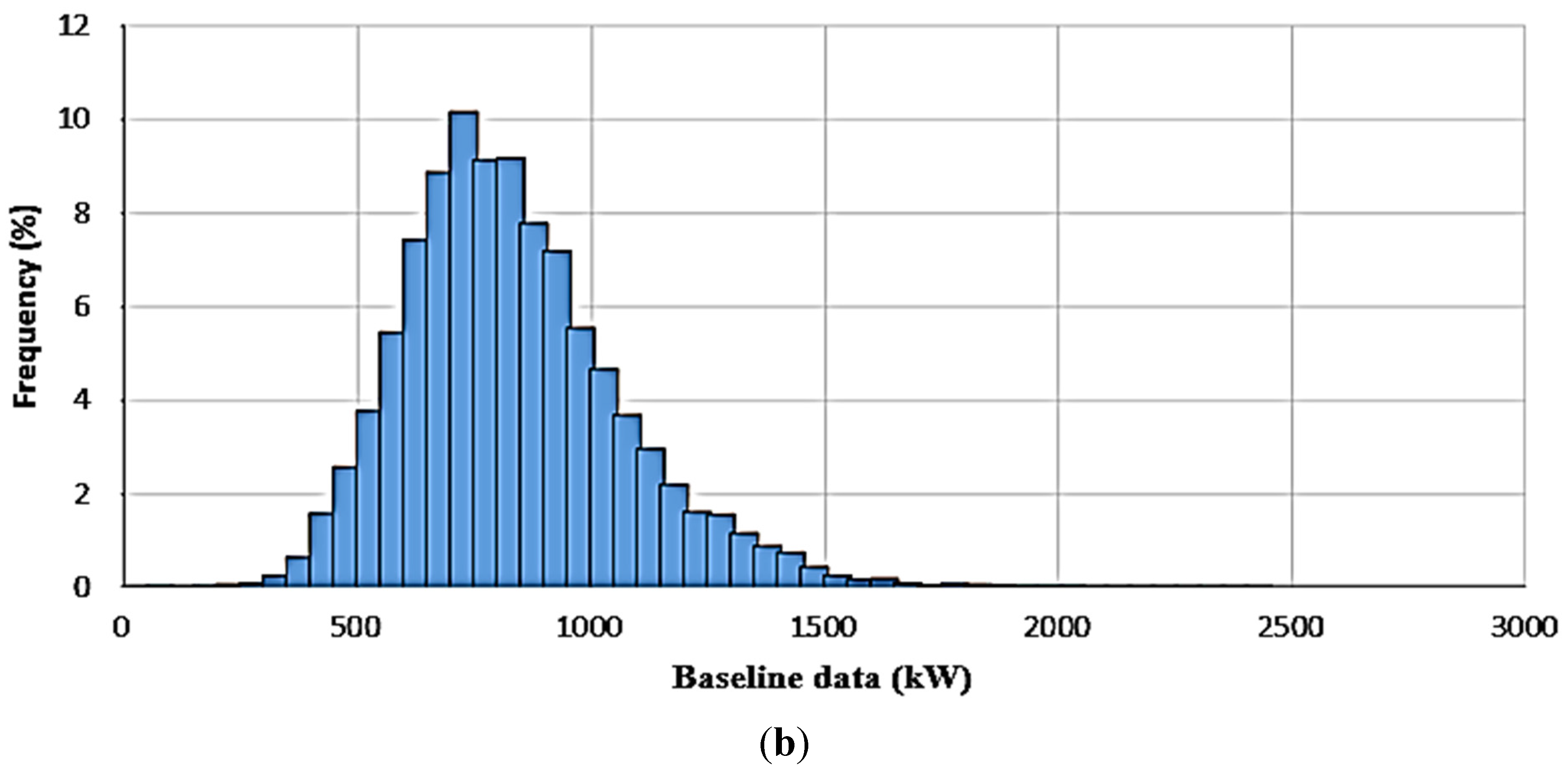
4. The Resources of Solar Radiation, Wind Speed and Temperature
5. Hybrid System Modeling
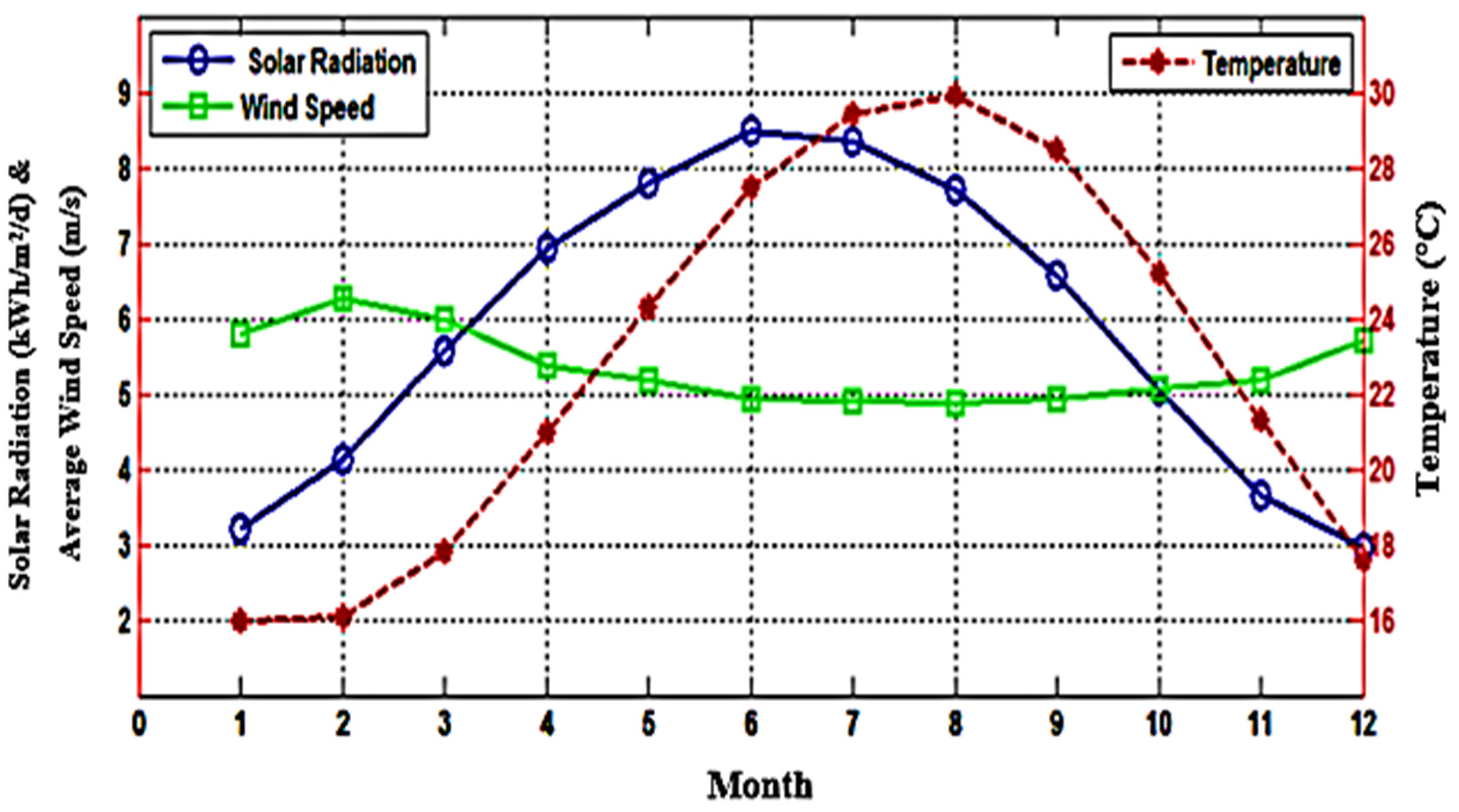
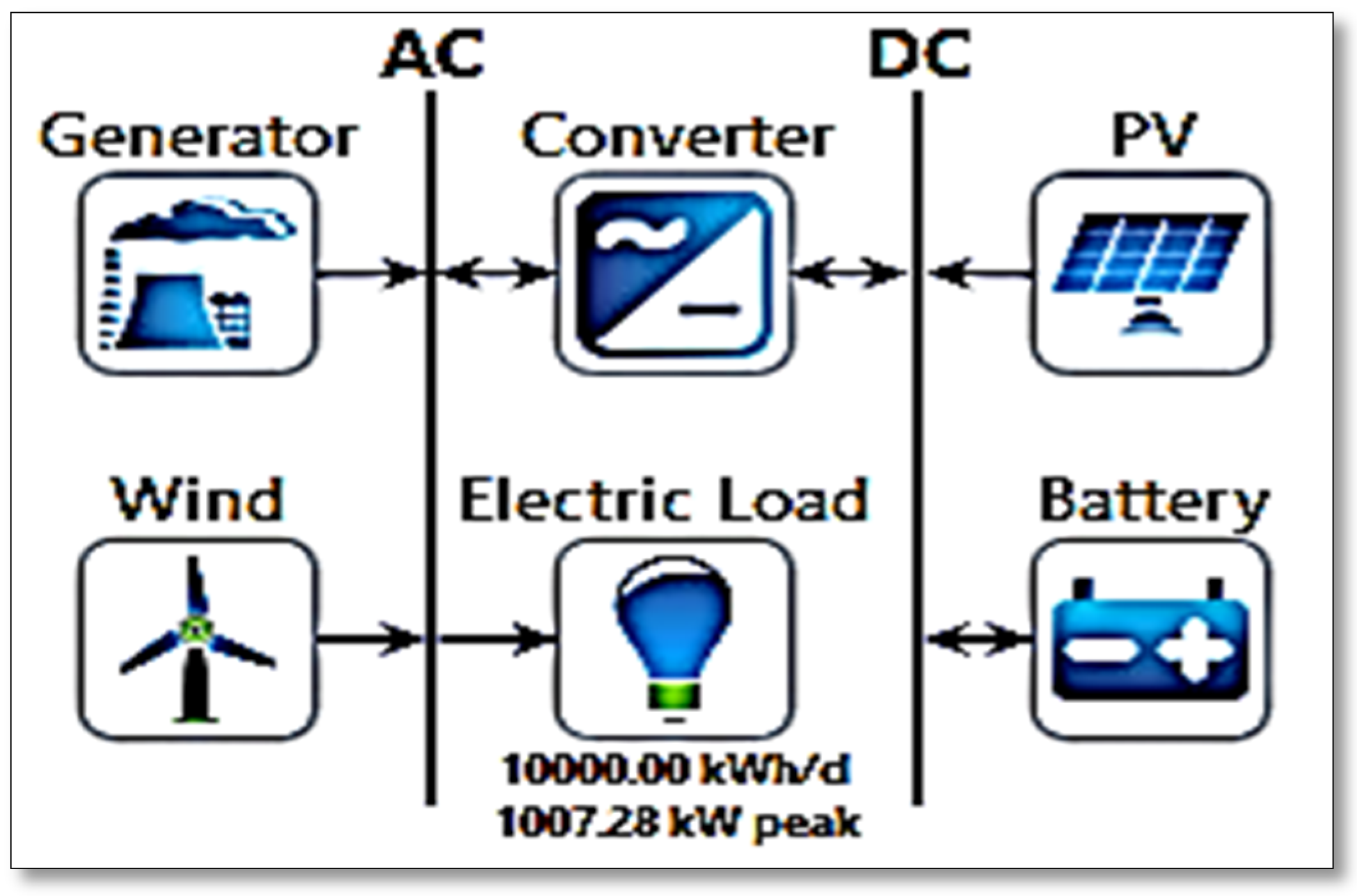
6. Results and Discussion
- 1
- PV panels (1600 kW), Figure 6 shows the yearly power output of the PV system of the HRES for the proposed tourist village in the study. The mean power output of the PV is 383.8 kW of the total rated capacity 1600 kW (capacity factor is 23.988%); the time of operation of the PV during the year is 4385 h. The levelized COE using the PV power is $0.0595/kWh.
- 2
- Wind turbines (1000 kW), Figure 7a,b show the yearly wind power output and Weibull probability distribution function of the wind speed histogram of the HRES for the proposed tourist village in the study. The mean power output of the wind turbine is 273.17 kW of the total rated capacity 1000 kW (capacity factor is 27.317%); the time of operation of the wind turbine during the year is 7426 h. The levelized COE using the wind turbine power is $0.0752/kWh.Figure 6. The yearly PV power output of the HRES for the proposed tourist village in the study.Figure 7. (a) The yearly wind turbine power output of the HRES for the proposed tourist village in the study; (b) Weibull probability distribution function of wind speed histogram.Figure 7. (a) The yearly wind turbine power output of the HRES for the proposed tourist village in the study; (b) Weibull probability distribution function of wind speed histogram.
- 3
- Diesel generator (200 kW), Figure 8 shows the yearly diesel generator power output of the HRES for the proposed tourist village in the study. The maximum power output of the diesel generator is 200 kW, the minimum power output is 50 kW and the mean power output is 146.24 kW. The time of operation of the diesel generator is 225 h in five starts during the year as shown in Figure 8. Additionally, the total consumed amount of fuel is 11,570 L/year and the marginal generation cost of the diesel generator is $0.06/kWh.Figure 8. The yearly diesel generator power output of the HRES for the proposed tourist village in the study.Figure 8. The yearly diesel generator power output of the HRES for the proposed tourist village in the study.
- 4
- Power converters (1000 kW), Figure 9a,b show the yearly rectifier and inverter power input and power output of the HRES for the proposed tourist village in the study. It should be noted that the converter has two functions; first rectifier to convert AC power to DC power (batteries charger), second inverter to convert DC power to AC power (energy flow from the PV or the batteries to the AC load). The energy output from the rectifier is 229,757 kWh/year while the energy input to the rectifier is 270,303 kWh/year with losses of 40,546 kWh/year. The time of operation of the power converter as a rectifier during the year is 1433 h. The energy output from the inverter is 2,045,117 kWh/year while the energy input to the inverter is 2,272,351 kWh/year with losses of 227,234 kWh/year. The time of operation of the power converter as an inverter during the year is 6295 h.Figure 9. (a) The yearly rectifier power input and power output; (b) the yearly inverter power input and power output.Figure 9. (a) The yearly rectifier power input and power output; (b) the yearly inverter power input and power output.
- 5
- Batteries (2000 batteries, with the capacity of 589 Ah each), Figure 10a,b show the yearly battery charging and discharging power and maximum power. Figure 10c shows the yearly batteries input power and batteries state of charge. The batteries state of charge is around 100% most of the year. The energy output from the batteries is 1,346,038 kWh/year while the energy input to the batteries is 1,569,687 kWh/year with losses of 214,431 kWh/year and storage depletion of 9218 kWh/year. Additionally, the expected lifetime of the batteries is 17.26 years.
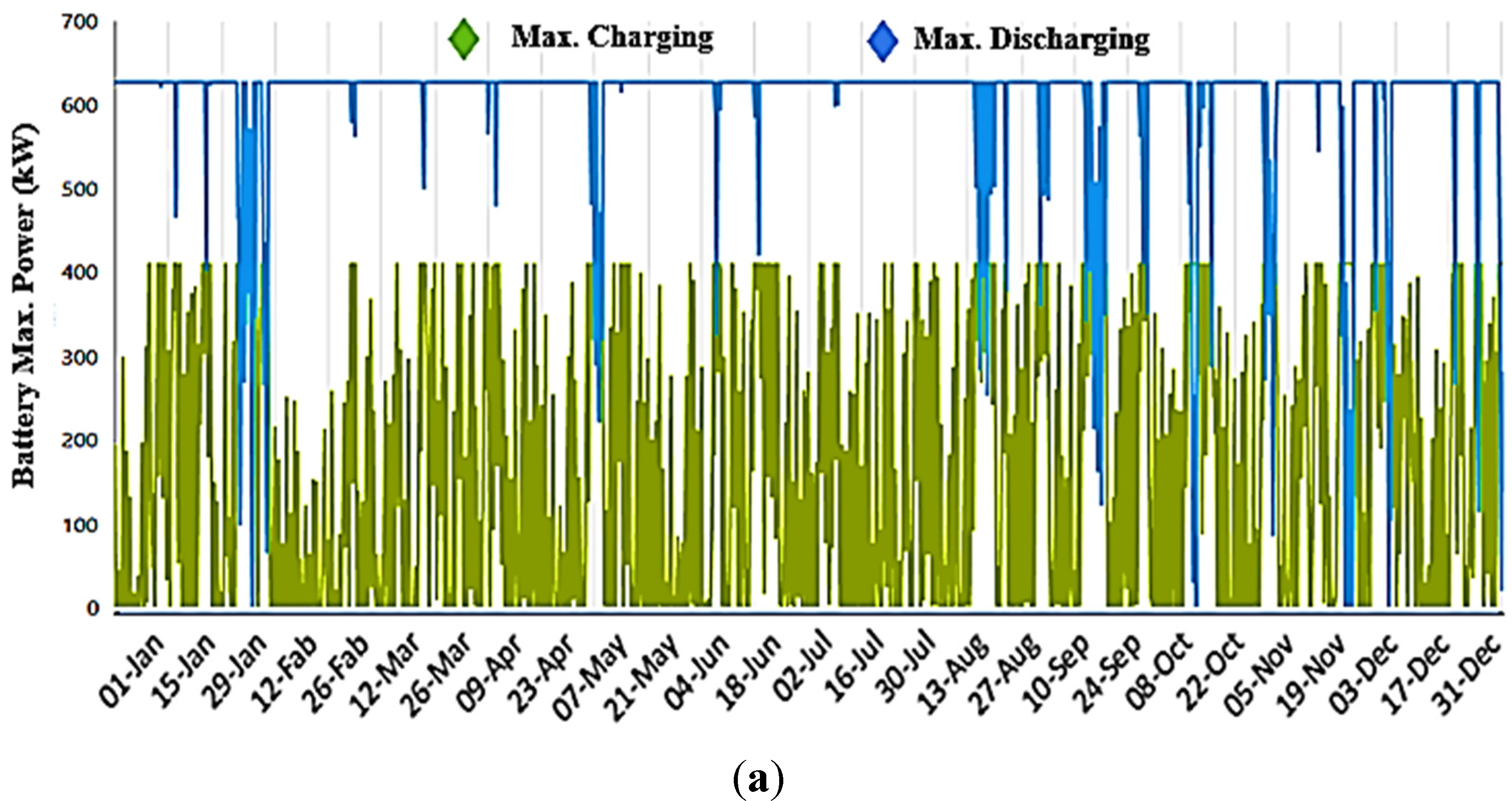
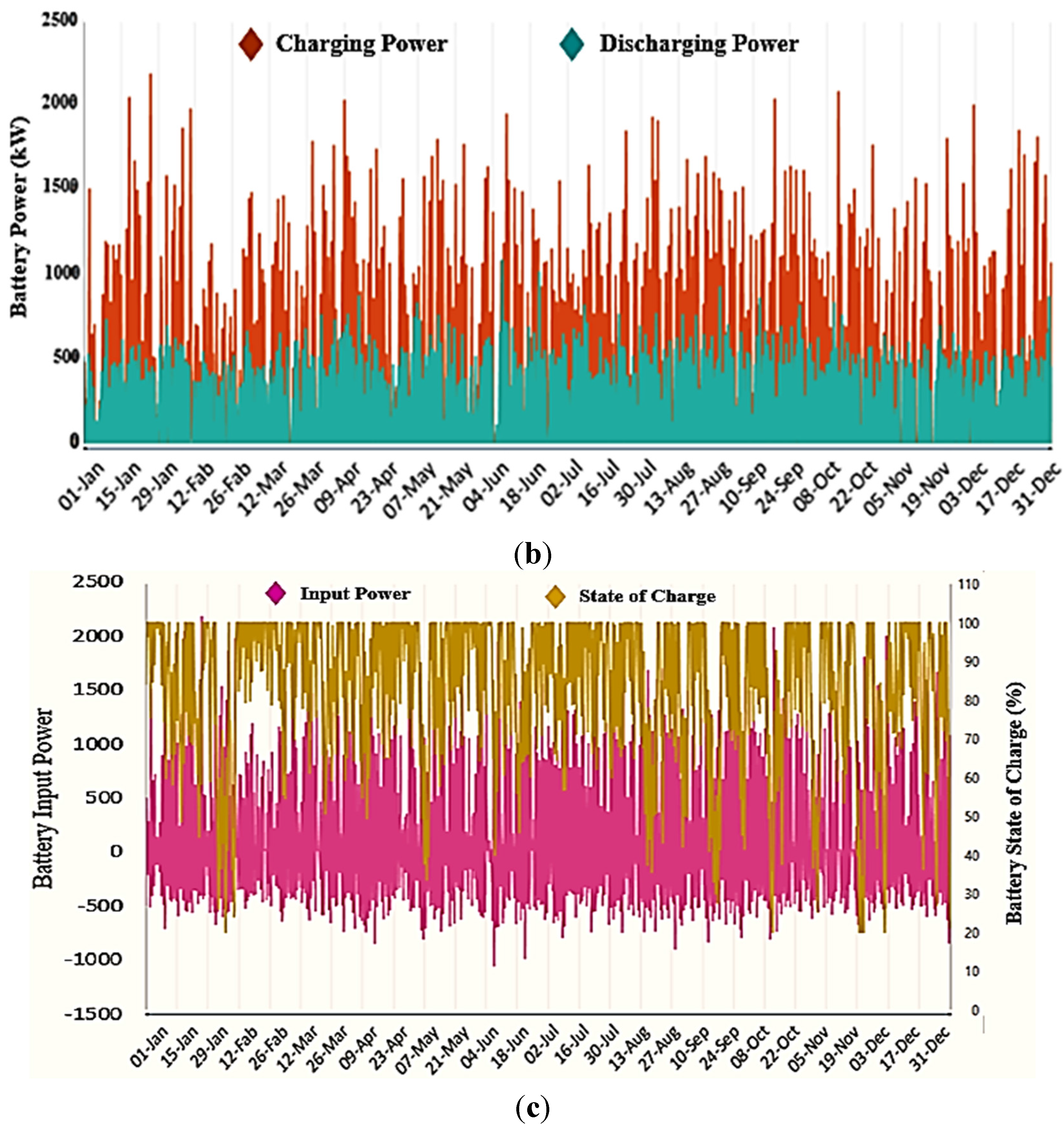
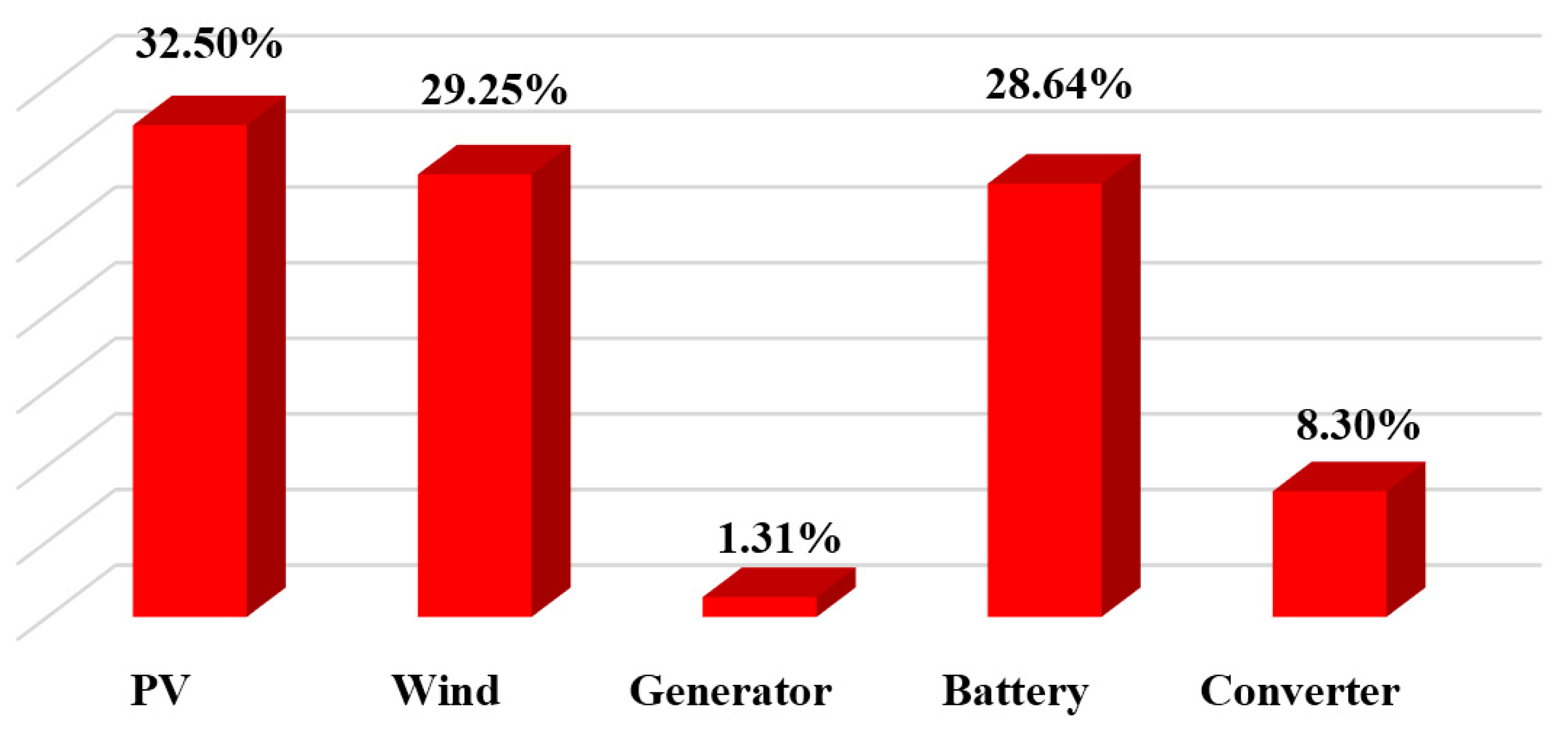
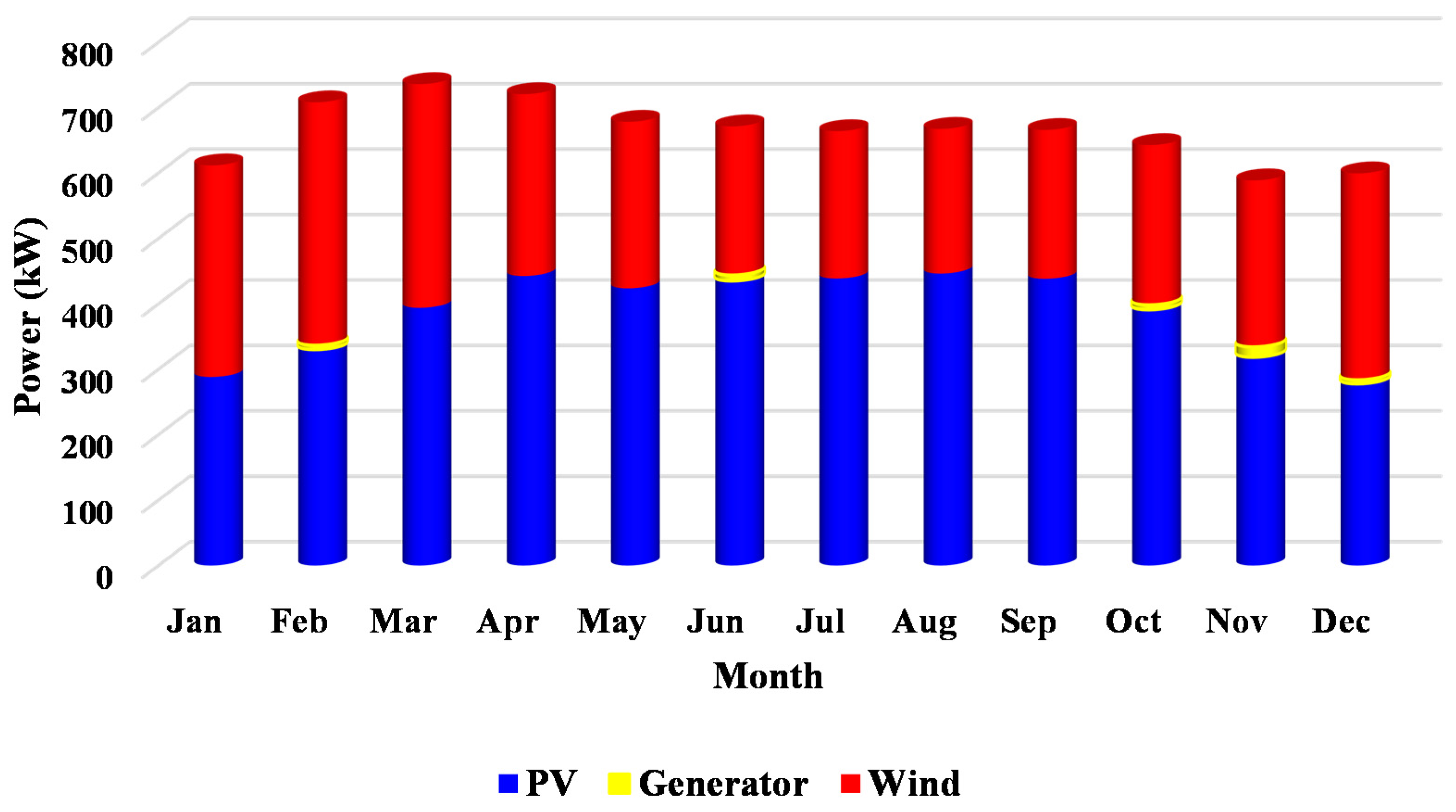
- the total annual capacity shortage (kWh/year).
- the total annual electric demand ( primary plus deferrable) (kWh/year).
- the total annual unmet electric load (kWh/year).
7. Conclusions
- 1
- Alexandria is the optimum Egyptian tourist city to establish an environmentally-friendly tourist village in comparison with the other four tourist cities (Luxor, Giza, Qena and Aswan).
- 2
- The hybrid PV/wind/diesel/battery system is found to be the optimum HRES for the proposed tourist village in Alexandria according to the economic cost (cost of energy (COE) and net present cost (NPC)) and the amount of GHG emitted.
- 3
- The optimum HRES consists of 1600 kW of PV panels, 1000 kW of wind turbines, 1000 kW of power converters, 200 kW diesel generator and 2000 batteries with the capacity of 589 Ah each.
- 4
- The cost of PV system, wind turbines, diesel generator, batteries and power converters during the 25 years the project’s lifetime, using 8% annual interest rate are $5,000,000, $4,500,000, $202,851, $4,405,509 and $1,275,000 respectively.
- 5
- The levelized COE from the optimum HRES is $0.17/kWh, which is the least expensive COE in comparison with other systems configurations additionally, the total NPC of this system is $15,383,360.
- 6
- The maximum renewable energy fraction of the optimum system is 99.1%, In other words, we have achieved a zero sustainable energy tourist village.
- 7
- The amount of greenhouse gases (GHG) emitted from the optimum HRES is only 31,289 kg/year, which is negligible in comparing with the other system configurations, therefore the optimum HRES can be considered as a green system.
- 8
- The electricity produced from the diesel generator is only 0.57% (32,903 kWh/year). Additionally, the excess electricity produced by the optimum HRES can be used by any dump load in the form of a heating or cooling load, which would increase the efficiency of the optimum HRES and decrease the levelized COE less than $0.17/kWh.
- 9
- The achieved percentage of the capacity shortage of the optimum HRES is only 0%, which means this system is a reliable system.
- 10
- The achieved percentage of the unmet load of the optimal HRES is only 0%. Additionally, the same study can be applied on any other application in any other site in the world by maximizing the renewable energy fraction and minimizing the greenhouse gases emissions, which could provide more benefits by reducing CO2 emissions and providing a reliable supply of electricity in all load conditions.
Author Contributions
Conflicts of Interest
References
- Alexandria Wikipedia. Available online: http://en.wikipedia.org/wiki/Alexandria (accessed on 17 April 2015).
- Alexandria Portal, Alexandria Tourism. Available online: http://www.alexandria.gov.eg/services/tourism/alextourism/beaches.html (accessed on 17 April 2015). (In Arabic)
- Diab, F.; Lan, H.; Zhang, L.; Ali, S. An environmentally-friendly tourist village in Egypt based on a hybrid renewable energy system—Part one: What is the optimum city? Energies 2015, 8, 6926–6944. [Google Scholar]
- Hassoun, A.; Dincer, I. Development of power system designs for a net zero energy house. Energy Build. 2014, 73, 120–129. [Google Scholar] [CrossRef]
- Iqbal, M.T. A feasibility study of a zero energy home in Newfoundland. Renew. Energy 2004, 29, 277–289. [Google Scholar] [CrossRef]
- Scognamiglio, A.; Adinolfi, G.; Graditi, G.; Saretta, E. Photovoltaics in net zero energy buildings and clusters: Enabling the smart city operation. Energy Procedia 2014, 61, 1171–1174. [Google Scholar] [CrossRef]
- Said, M.; EL-Shimy, M.; Abdelraheem, A. Photovoltaics’ energy: Improved modeling and analysis of the levelized cost of energy (LCOE) and grid parity––Egypt case study. Sustain. Energy Technol. Assess. 2015, 9, 37–48. [Google Scholar] [CrossRef]
- Kylili, A.; Fokaides, A. European smart cities: The role of zero energy buildings. Sustain. Cities Soc. 2015, 15, 86–95. [Google Scholar] [CrossRef]
- Elkinton, R.; McGowan, G.; Manwell, F. Wind power systems for zero net energy housing in the United States. Renew. Energy 2009, 34, 1270–1278. [Google Scholar] [CrossRef]
- Gallo, A.; Molina, B.; Prodanovic, M.; Aguilar, J.; Romero, M. Analysis of net zero-energy building in Spain, integration of PV, solar domestic hot water and air-conditioning systems. Energy Procedia 2014, 48, 828–836. [Google Scholar] [CrossRef]
- Da Graça, G.; Augusto, A.; Lerer, M. Solar powered net zero energy houses for southern Europe: Feasibility study. Solar Energy 2012, 86, 634–646. [Google Scholar] [CrossRef]
- Norisa, F.; Musallb, E.; Salomc, J.; Berggrend, B.; Jensene, S.; Lindberg, K.; Sartori, I. Implications of weighting factors on technology preference in net zero energy buildings. Energy Build. 2014, 82, 250–262. [Google Scholar] [CrossRef]
- Rodriguez-Ubinas, E.; Montero, C.; Porteros, M.; Vega, S.; Navarro, I.; Castillo-Cagigal, M.; Matallanas, E.; Gutiérrez, A. Passive design strategies and performance of net energy plus houses. Energy Build. 2014, 83, 10–22. [Google Scholar] [CrossRef]
- Song, Y.; Sun, J.; Li, J.; Xie, D. Towards net zero energy building: Collaboration-based sustainable design and practice of the Beijing waterfowl pavilion. Energy Procedia. 2014, 57, 1773–1782. [Google Scholar] [CrossRef]
- Wang, L.; Gwilliam, G.; Jone, P. Case study of zero energy house design in UK. Energy Bulid. 2009, 41, 1215–1222. [Google Scholar] [CrossRef]
- Lu, Y.; Wang, S.; Zhao, Y.; Yan, C. Renewable energy system optimization of low/zero energy buildings using single-objective and multi-objective optimization methods. Energy Bulid. 2015, 89, 61–75. [Google Scholar] [CrossRef]
- Pudleiner, D.; Colton, J. Using sensitivity analysis to improve the efficiency of a net-zero energy vaccine warehouse design. Build. Environ. 2015, 87, 302–314. [Google Scholar] [CrossRef]
- Milan, C.; Bojesen, C.; Nielsen, M. A cost optimization model for 100% renewable residential energy supply systems. Energy 2012, 48, 118–127. [Google Scholar] [CrossRef]
- Marszal, A.; Heiselberg, P.; Jensen, R.; Nørgaard, J. On-site or off-site renewable energy supply options? Life cycle cost analysis of a net zero energy building in Denmark. Renew. Energy 2012, 44, 154–165. [Google Scholar] [CrossRef]
- Kwan, C.; Kwan, T. The financials of constructing a solar PV for net-zero energy operations on college campuses. Util. Policy 2011, 19, 226–234. [Google Scholar] [CrossRef]
- Deng, S.; Dalibard, A.; Martin, M.; Dai, J.; Eicker, U.; Wanga, Z. Energy supply concepts for zero energy residential buildings in humid and dry climate. Energy Conv. Manag. 2011, 52, 2455–2460. [Google Scholar] [CrossRef]
- Salom, J.; Marszal, A.; Widén, J.; Candanedo, J.; Byskov, K. Analysis of load match and grid interaction indicators in net zero energy buildings with simulated and monitored data. Appl. Energy 2014, 136, 119–131. [Google Scholar] [CrossRef]
- Adhikari, R.; Aste, N.; Pero, C.; Manfren, M. Net zero energy buildings: Expense or investment? Energy Procedia. 2012, 14, 1331–1336. [Google Scholar] [CrossRef]
- Heffernan, E.; Pan, W.; Liang, X.; de Wilde, P. Zero carbon homes: Perceptions from the UK construction industry. Energy Policy 2015, 79, 23–36. [Google Scholar] [CrossRef]
- Pacheco, M.; Lamberts, R. Assessment of technical and economical viability for large-scale conversion of single-family residential buildings into zero energy buildings in Brazil: Climatic and cultural considerations. Energy Policy 2013, 63, 716–725. [Google Scholar] [CrossRef]
- Kilkis, S. A net-zero building application and its role in exergy-aware local energy strategies for sustainability. Energy Conv. Manag. 2012, 63, 208–217. [Google Scholar] [CrossRef]
- Kilkis, S. Energy system analysis of a pilot net-zero exergy district. Energy Conv. Manag. 2014, 87, 1077–1092. [Google Scholar] [CrossRef]
- Thomas, W.; Duffy, J. Energy performance of net-zero and near net-zero energy homes in New England. Energy Bulid. 2013, 67, 551–558. [Google Scholar] [CrossRef]
- Moore, T. Modelling the through-life costs and benefits of detached zero (net) energy housing in Melbourne, Australia. Energy Bulid. 2014, 70, 463–471. [Google Scholar] [CrossRef]
- Saman, Y. Towards zero energy homes down under. Renew. Energy 2013, 49, 211–215. [Google Scholar] [CrossRef]
- Becchio, C.; Dabbene, P.; Fabrizio, E.; Monetti, V.; Filippi, M. Cost optimality assessment of a single-family house: Building and technical systems solutions for the NZEB target. Energy Bulid. 2015, 90, 173–187. [Google Scholar] [CrossRef]
- Dall’O’, G.; Bruni, E.; Sarto, L. An Italian pilot project for zero energy buildings: Towards a quality-driven approach. Renew. Energy 2013, 50, 840–846. [Google Scholar] [CrossRef]
- Cellura, M.; Guarino, F.; Longo, S.; Mistretta, M. Different energy balances for the redesign of nearly net zero energy buildings: An Italian case study. Renew. Sustain. Energy Rev. 2015, 45, 100–112. [Google Scholar] [CrossRef]
- Jina, Y.; Wang, L.; Xiong, Y.; Cai, H.; Li, Y.; Zhang, W. Feasibility studies on net zero energy building for climate considering: A case of “All Green House” for Datong, Shanxi, China. Energy Bulid. 2014, 85, 155–164. [Google Scholar] [CrossRef]
- Zhang, H.; Li, J.; Dong, L.; Chen, H. Integration of sustainability in net-zero house: Experiences in solar decathlon China. Energy Procedia. 2014, 57, 1931–1940. [Google Scholar] [CrossRef]
- Kalinci, Y. Alternative energy scenarios for Bozcaada Island, Turkey. Renew. Sustain. Energy Rev. 2015, 45, 468–480. [Google Scholar] [CrossRef]
- Alrashed, F.; Asif, M. Analysis of critical climate related factors for the application of zero-energy homes in Saudi Arabia. Renew. Sustain. Energy Rev. 2015, 41, 1395–4103. [Google Scholar] [CrossRef]
- Zabaneh, A. Zero net house: Preliminary assessment of suitability for Alberta. Renew. Sustain. Energy Rev. 2011, 15, 3237–3242. [Google Scholar] [CrossRef]
- U.S. Energy Information Administration. Available online: http://www.eia.gov/countries/country-data.cfm?fips=EG (accessed on 18 April 2015).
- Sinha, S.; Chandel, S. Review of software tools for hybrid renewable energy systems. Renew. Sustain. Energy Rev. 2014, 32, 192–205. [Google Scholar] [CrossRef]
- NASA Surface Meteorology and Solar Energy. Available online: https://eosweb.larc.nasa.gov/cgi-bin/sse/grid.cgi?email=skip@larc.nasa.gov (accessed on 5 April 2015).
- Ramli, M. Optimal sizing of grid-connected photovoltaic energy system in Saudi Arabia. Renew. Energy 2015, 75, 489–495. [Google Scholar] [CrossRef]
- Zhao, B.; Zhang, X.; Li, P.; Wang, K.; Xue, M.; Wang, C. Optimal sizing, operating strategy and operational experience of a stand-alone microgrid on Dongfushan Island. Appl. Energy 2014, 113, 1656–1666. [Google Scholar] [CrossRef]
© 2015 by the authors; licensee MDPI, Basel, Switzerland. This article is an open access article distributed under the terms and conditions of the Creative Commons Attribution license (http://creativecommons.org/licenses/by/4.0/).
Share and Cite
Diab, F.; Lan, H.; Zhang, L.; Ali, S. An Environmentally-Friendly Tourist Village in Egypt Based on a Hybrid Renewable Energy System––Part Two: A Net Zero Energy Tourist Village. Energies 2015, 8, 6945-6961. https://doi.org/10.3390/en8076945
Diab F, Lan H, Zhang L, Ali S. An Environmentally-Friendly Tourist Village in Egypt Based on a Hybrid Renewable Energy System––Part Two: A Net Zero Energy Tourist Village. Energies. 2015; 8(7):6945-6961. https://doi.org/10.3390/en8076945
Chicago/Turabian StyleDiab, Fahd, Hai Lan, Lijun Zhang, and Salwa Ali. 2015. "An Environmentally-Friendly Tourist Village in Egypt Based on a Hybrid Renewable Energy System––Part Two: A Net Zero Energy Tourist Village" Energies 8, no. 7: 6945-6961. https://doi.org/10.3390/en8076945
APA StyleDiab, F., Lan, H., Zhang, L., & Ali, S. (2015). An Environmentally-Friendly Tourist Village in Egypt Based on a Hybrid Renewable Energy System––Part Two: A Net Zero Energy Tourist Village. Energies, 8(7), 6945-6961. https://doi.org/10.3390/en8076945




